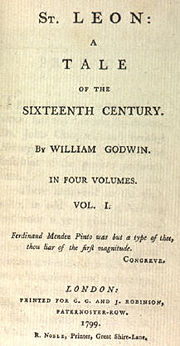
St. Leon (novel)
Encyclopedia

William Godwin
William Godwin was an English journalist, political philosopher and novelist. He is considered one of the first exponents of utilitarianism, and the first modern proponent of anarchism...
second novel.
The novel takes place during the Protestant Reformation and tells the tale of a penurious noble who finds the philosopher's stone
Philosopher's stone
The philosopher's stone is a legendary alchemical substance said to be capable of turning base metals into gold or silver. It was also sometimes believed to be an elixir of life, useful for rejuvenation and possibly for achieving immortality. For many centuries, it was the most sought-after goal...
and an elixir
Elixir
An elixir is a clear, sweet-flavored liquid used for medicinal purposes, to be taken orally and intended to cure one's ills. When used as a pharmaceutical preparation, an elixir contains at least one active ingredient designed to be taken orally....
of immortality
Immortality
Immortality is the ability to live forever. It is unknown whether human physical immortality is an achievable condition. Biological forms have inherent limitations which may or may not be able to be overcome through medical interventions or engineering...
. Unbounded wealth and immortality become the cause of St. Leon's downfall, turning him into a solitary loner, far removed from society. St. Leon examines the problems faced by a man eager to help humanity but whose efforts are checked by human beliefs and ignorance.
Plot
Set in Europe during the Protestant Reformation, St. Leon relates the travails of an impoverished French aristocrat, Count Reginald de St. Leon, who obtains the philosopher's stone and the elixir of immortality, elixir vitae, from a mysterious stranger named Francesco Zampieri. In this philosophical fable, endless riches and immortal life prove to be curses rather than gifts and transform St. Leon into an outcast. St. Leon becomes an alchemist who can create gold and who possesses immortal life. As a result, his son Charles rejects him, he is separated from his daughters, and his wife Marguerite de Damville becomes impoverished and dies. He is the target of German authorities and the Spanish Inquisition. He also encounters a Hungarian misanthrope named Bethlem Gabor. William Godwin's second Gothic novel explores the predicament of a would-be philanthropist whose attempts to benefit humanity are frustrated by superstition and ignorance.The novel explores the themes of immortality, the domestic affections, and alchemy. The novel is a radical experiment in fictional genres. Into a historical novel of vast range and violence Godwin melded elements of the domestic novel, the philosophical novel, and the scientific fantasy. More relentlessly than the earlier Caleb Williams, this novel tests Godwin's philosophical premises to destruction, showing the importance—and failure—of family affections and the disintegration of effective social responsibility.
Influence
St. Leon influenced the 1811 Gothic novel St. Irvyne; or, The Rosicrucian by Percy Bysshe ShelleyPercy Bysshe Shelley
Percy Bysshe Shelley was one of the major English Romantic poets and is critically regarded as among the finest lyric poets in the English language. Shelley was famous for his association with John Keats and Lord Byron...
and Frankenstein
Frankenstein
Frankenstein; or, The Modern Prometheus is a novel about a failed experiment that produced a monster, written by Mary Shelley, with inserts of poems by Percy Bysshe Shelley. Shelley started writing the story when she was eighteen, and the novel was published when she was twenty-one. The first...
(1818), which was dedicated to William Godwin.
External links
- St. Leon at Google Books

